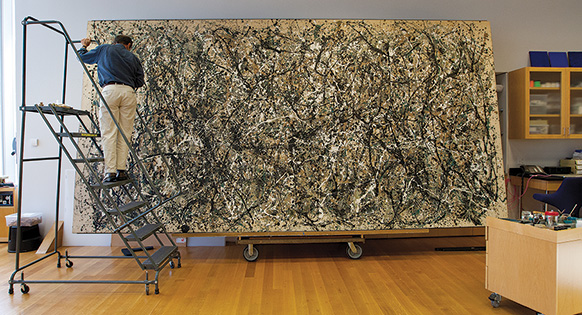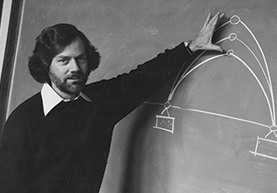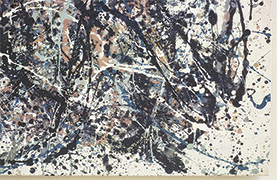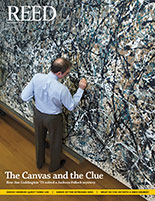
IRIS login | Reed College home Volume 92, No. 3: September 2013
The Canvas and the Clue (continued)

Jim Coddington, chief conservator of the Museum of Modern Art, looks at Jackson Pollock’s One: Number 31, 1950, in the conservation lab at the museum in New York, August 27, 2012. Photo by Ruth Fremson/The New York Times
Coddington compared the process to his previous restoration of the 20th century’s most important painting, Picasso’s Les Demoiselles d’Avignon: The steady, if reluctant, Mr. Fixit recounted how the wear and tear sustained by Picasso’s canvas became apparent only after it hung in a special exhibition with other period artworks. “That’s when we realized that the Demoiselles didn’t steal the show the way the history of art would have predicted,” Coddington recalled. “And it was our opinion that it was not Picasso’s fault—it had to do with the condition of the painting. We looked into it for the next two years, and saw that the painting had received several restorations, and the restoration materials had begun to discolor and mute the picture. The path that led to repairing the Pollock was similar. We saw it in contrast with other related pictures and noticed through that comparison how it had changed over time.”
A bespectacled, deliberate man with the bearing of the scientist he might have become if he had not found his true calling in a Reed humanities course, Coddington remembers perfectly the life-changing effect one special teacher had on him during his years in Portland—the late art historian Prof. Charles Rhyne [art 1960–97]. “I was a biology major, but the soil that fed my professional life was really prepared in Charles Rhyne’s introductory art history class. That class taught me, among other things, that art is everywhere; but Charles’ course also taught me a lot about the materials that art is made from. As I got more interested, I concentrated on the idea that people made art from real things in the world. At some point a light bulb went off in my head—that synaptic connection joined my interest in science with my love of art history. After that, one thing just led to another.”
Jim Coddington ’74, the Museum of Modern Art's chief conservator, comments on the restoration of Jackson Pollock's One: Number 31, 1950.
Video produced by Museum of Modern Art
After graduating from Reed, he and Rhyne stayed in touch, speaking often and directly enough to form a lifelong friendship. The older scholar often counseled the younger man as he finished graduate work and, later, as his career developed. “To talk to Charles was to speak to someone who was intensely knowledgeable, interested in what I was doing, and who made me think differently by the time each conversation was over. His curiosity was boundless. How he morphed from teacher to friend and colleague was very fluid, but I have to say that he remained my mentor for many, many years.” Still, nearly four decades after Coddington left Portland for study and work on the East Coast, few could have predicted that both men would collaborate on a major art historical finding in 2013. The timing would prove crucial, as the 81-year-old Rhyne died in April of this year.
As Coddington and his staff completed their initial research and began the process of cleaning One, a previously unseen problem suddenly became crystal clear: areas of the painting contained patches of polyvinyl acetate. A synthetic resin-based paint that, according to Coddington, American artists ignored during the 1950s—but restorers had used freely since the 1930s—it had been applied in “fussy brushstrokes” that were totally unlike Pollock’s style. The marks, said Coddington, looked like they’d been put there to “cover up small cracks” in the enamel paint.
The circumstances were suggestive, but in order to avoid endangering the painting, Coddington needed to be sure. Stumped by the absence of restoration records, he turned to his secret weapon: a cache of photographs taken by Rhyne in 1962.
Rhyne’s renown as a scholar and teacher was matched only by the many honors he collected—among them, the American Institute for Conservation’s Special Recognition for Allied Professionals for his “invaluable contributions to art conservation.” He nourished a lifelong commitment to photography and digital imaging as research tools. “A tremendous amount of information is conveyed in visual images,” Rhyne told an interviewer in 1994. “Academics have valued the written word, but have tended to overlook the amount of evidence and information retained in visual images.” But Rhyne’s dedication to photography was no case of mere record keeping. It was instead, says Coddington, the ultimate grail of visual documentation—“close looking.”
In 1962, the Portland Art Museum showed several Pollocks from the collection of New York industrialist Ben Heller, whom Mark Rothko once called “the Frick of the Upper West Side.” Rhyne—then just two years into his job at Reed—took scrupulous photographs of One. “Should you ever need them, let me know,” he wrote to Coddington in 1998.
Coddington filed that information in the back of his mind. “Before we started the conservation, I got in touch with Charles and said, ‘I’d like to see those photos.’ He sent them and, bingo, one of the pictures suddenly made things absolutely clear. The remarkable thing about Charles’ photos is that they were of details. They virtually define the idea of close looking, especially one image that was a 35-mm slide of the lower right corner of the painting. Looking at it, it became obvious that what was in the painting in 2012 was not there in 1962. Since Pollock died in 1956, that basically ended the discussion as to whether those changes were by the artist himself.”
The work of the conservator can be defined as that of a reluctant fixer. The profession is informed at its highest level by the constant knowledge that no intervention is neutral. Coddington himself admitted this to me inside the sanctum sanctorum that is MoMA’s restoration floor, declaring that he is often simply “loath to restore a picture.” “Sometimes we take on the attitude of doctors,” he said, invoking additional medical parlance. “What’s called ‘watchful waiting.’ That’s where essentially you’re aware that problems exist, but they haven’t risen to the level of urgency that warrants an actual intervention.”
But in the case of One, an earlier restoration required Coddington and his staff to fix what he judged to be repairs made to what was a slightly cracked but essentially undamaged painting. “I think any new work of art, if it starts to show age early, is somehow thought to be deficient,” Coddington said about the Pollock’s anonymous restoration—it took place sometime between 1962 and 1968 when it entered the museum’s collection—which the conservator corrected in part by revealing parts of the original surface, including bits of wood and a fly embedded in its surface. “When One started to show cracks, the restorer probably thought, well, I’ll make those cracks disappear. On the other hand, we have no problem with cracks in a Rembrandt.”
In this Coddington and his staff at MoMA were greatly aided by Rhyne’s detailed photographic documentation—just as conservators in another major international museum have been thus far. Rhyne not only documented Pollock’s One in glorious detail; it turns out he also took many photos of other works in Heller’s collection, including the celebrated Pollock painting Blue Poles, now at the National Gallery of Australia. After Coddington recently sent those scans off to Australia, the museum responded with a combination of shock and gratitude: “We have nothing like this documentation,” they told Coddington. “This is totally unique.”
As MoMA’s chief fixer relayed this story, his voice wavered just a bit. “Nobody else had thought it important enough to assemble this kind of detailed documentation,” he said proudly. “But to Charles it was second nature. In the end, he not only changed my life, he changed the life of these pictures.”

The Wizard of Art and Time
Prof. Charles Rhyne [art history 1960–97] was internationally renowned for his wide-ranging expertise in art history, from the English landscape painter John Constable to the theory and practice of conservation, Northwest Coast Native American art, and the use of digital images in research and teaching. His lifelong interest in photography was the basis of all his other work; his slides and digital images were his research notes, providing evidence of how things were and how they change over time. They resulted in three major websites: Ara Pacis Augustae; Architecture, Restoration, and Imaging of Uxmal, Kabah, Sayil, and Labná; and Architecture of the Getty Center. In addition to the nearly 2,000 photographs he took for his Ara Pacis Augustae website, Charles photographed wooden churches in Russia, American covered bridges, and master paintings on their way through the Portland Art Museum’s collection.
The conservation of art and architecture was central to his life’s work, and his research concerned everything from technical investigations into how masonry deteriorates to broad cultural issues, like the preservation of Native American art. Addressing the issue of preserving Native American totem poles, Rhyne said, “People think it’s very simple: you either preserve or you don’t. I try to lay out the complexity of things.” A single totem pole, he explained, could present many options. Should yellow jackets be prevented from nesting in the pole or seedlings be plucked from its cracks? Should it be stabilized, or righted and placed in the same position it was in 19th-century photographs? Do you fill in cracks and repaint the pole? “Each of these choices is an emotionally charged issue and the complexity of the situation is immense. It’s not just a matter of preserving or not. It’s how you should preserve it and if you preserve it, whether you display it and how you display it.”
- Previous Page
- 1
- 2
- Next Page


LATEST COMMENTS
steve-jobs-1976 I knew Steve Jobs when he was on the second floor of Quincy. (Fall...
Utnapishtim - 2 weeks ago
Prof. Mason Drukman [political science 1964–70] This is gold, pure gold. God bless, Prof. Drukman.
puredog - 1 month ago
virginia-davis-1965 Such a good friend & compatriot in the day of Satyricon...
czarchasm - 4 months ago
John Peara Baba 1990 John died of a broken heart from losing his mom and then his...
kodachrome - 7 months ago
Carol Sawyer 1962 Who wrote this obit? I'm writing something about Carol Sawyer...
MsLaurie Pepper - 8 months ago
William W. Wissman MAT 1969 ...and THREE sisters. Sabra, the oldest, Mary, the middle, and...
riclf - 10 months ago